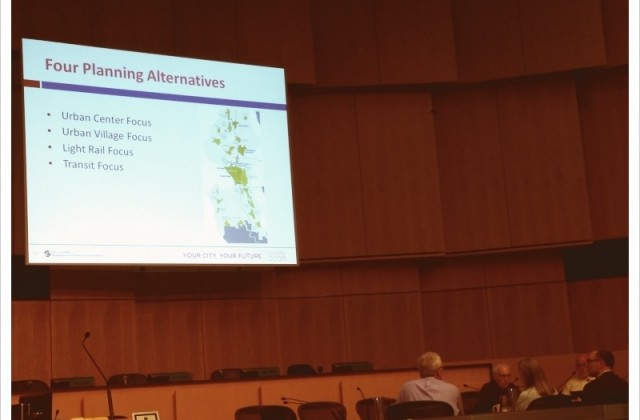Comprehensive Plan:Planning to Plan to Plan with Equity
Today at the Planning, Land Use, and Sustainability the Department of Planning and Development (DPD) trotted out their plan for planning the engagement on the Comprehensive Plan. Seriously. I’m not being snarky. We’ve already seen the DPD’s four options a while ago that suggest that we either grow in urban centers, urban villages, around rail, or around other transit. Easy. All of the above.
But that great local shibboleth, equity, was uttered again today in the context of the Comprehensive Plan. How would we achieve equity through our plan? When the word is mentioned now I instinctively mutter to myself “between what and what, or what people, places or things?” How will we measure the equity? Won’t it be evident when all things are, well, equal; the high places made low and the low places made high?
Probably not; but Councilmembers can’t resist talking about equity everywhere all the time (even when raising the City Light CEO’s salary to $364,000 per year). We are a progressive city after all. And it came up yesterday too when DPD staff earnestly presented their plan to plan for planning yet again. Somewhere in the Power Point was an American Planning Association goal for achieving something they call “Interwoven Equity” through a comprehensive plan.
What, exactly, is Interwoven Equity asked Councilmember Tim Burgess.
Interwoven Equity – ensure fairness and equity in providing for the housing, services, health, safety, and livelihood needs of all citizens and groups.
And did I tell you the story about that shaggy dog I saw the other day?
But to be fair (or equitable), I should point out that there are practices in the APA document that roll up to this vague definition larded with more terms without definition; these practices are not exactly measures, but things that could be looked at to determine whether the plan (not actual policy) lives up the ideal of Interwoven Equity.
Best Practices– the plan actions or elements, such as goals, objectives, policies, priorities, implementation or action steps or tasks, and maps that demonstrate a community’s commitment to pursue sustainability; these are the planning tools employed by the community to guide its planning, development, and decision-making.
What are the practices? Here’s where it gets interesting.
Range of housing types
Jobs/housing balance
Disadvantaged neighborhood improvement
At-risk population health & safety
Services & health care for minority, low income
Infrastructure upgrade in older neighborhoods
Workforce development policy
Protect vulnerable neighborhood s from natural hazards
Promote environmental Justice
All these are public goods, things that would be important for any city planning for the future. But some of these are obvious like range of housing type; that’s actually a founding principle of Smart Growth Seattle and of all housing supply advocates. We say it all the time: let’s builds more housing, of all types in all neighborhoods.
And I will be perfectly clear: when it comes to housing, we want every person to have access to shelter if they need it and housing that works for them. Accomplishing this means expanding housing choice and opportunity for all levels of income, and for people who can’t pay monthly rent that supports the debt to cover land and constructions costs, it means some level of subsidy.
The problem is when it comes to terms like “disadvantaged neighborhood improvement.” What does that actually mean? It could mean gentrification. Or it could mean investing in social services. More importantly how does one measure or define a “disadvantaged neighborhood?”
Many are skeptical of the Comprehensive Plan and the planning process since it has become mostly an aspirational document, not full of “thou shalt” language but “thou shalt try really hard.” And the hortatory language is riven with inconsistencies, calling for “protections” for single-family neighborhoods, but also infill development there, too.
Adding more overlays from the APA will simply muddle things further, especially if we try to plan to plan to plan for equity. We’ll never get closer to building more housing–or equity, however we define and measure it. Instead of chasing high ideals in our plan, shouldn’t we be pushing for high numbers of new housing units? All these great things in the APA document can happen if we welcome and plan for growth; but we need new people and jobs and houses and workplaces for them.
So the Comprehensive Planning process continues to be the Flying Dutchman of Seattle Process, unable really ever to settle in any port but sailing over 7 seas full of plannerese with it’s sails “strive,” “endeavor,” and “ensure” full of the hot winds born of many, many public meetings to talk about the plans, to plan, to plan. Can we make it more straightforward and inclusive without so much planner talk? Maybe we should propose an amendment to the process itself.


